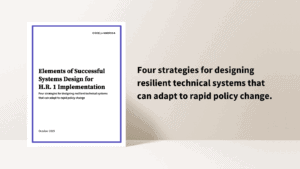- News and Stories
- Blog post
- Safety Net
Creating Adaptable Benefits Systems in a Changing Policy Landscape

Across the nation, state benefits administrators are facing the monumental challenge of figuring out how to implement new work requirements under H.R. 1, the law also known as the One Big Beautiful Bill Act. Signed into law in July 2025, this law requires certain individuals who receive food assistance via the Supplemental Nutrition Assistance Program or health care coverage via Medicaid to meet new or expanded work requirements. For SNAP clients, these changes will take effect on November 1—less than four months after the measure became law—or in some cases have already begun. And while the deadline for Medicaid isn’t until January 2027, the complexity of system changes required to implement brand new work requirements and the lack of federal guidance makes it an immense undertaking for state governments.
One of the biggest challenges states face is upgrading their benefits systems to comply with H.R. 1. Without proper guidance, states risk wasting time and money on making changes that fail to meet their needs, and because guidance from the federal government is still being actively drafted and released, there’s a good chance states will need to adjust their benefits systems in the near future. Substantial late-breaking changes could be costly and inefficient for state agencies that need to begin updating systems now to meet H.R. 1 implementation deadlines.
In civic tech, however, we are well-versed in thinking about how to maximize a system’s flexibility while minimizing its cost. This is part of what’s referred to as system design: the process of putting the various components of a system together in a way that optimizes scalability, flexibility, and reliability. For states working to implement work requirements or any other H.R. 1-related changes, good system design is essential. Change at the federal level may be out of states’ control, but when engaging with vendors to upgrade systems, states can advocate for quality and cost-effective system design by incorporating four standard principles: feature flags, modularity, configurability, and phased approaches.
Interested in learning more about how to ensure your state’s benefits system is best equipped to respond to H.R. 1-related changes?
Read our resource, Elements of Successful Systems Design for H.R. 1 Implementation, for guidance on best practices in systems design—and explore our Work Requirements Implementation Toolkit, a growing suite of resources to help states comply with new Medicaid and SNAP work requirements under H.R. 1.
Feature flags: An on/off switch for features
Feature flags act as an on/off switch for specific features in a system. As states implement new rules, certain features of their benefits systems that are necessary now may become unnecessary in the future. Making it easy to quickly shut off those unnecessary features within a system can minimize the cost of changes later on.
Modularity: The whole as a sum of its parts
A benefits system is like a puzzle, with multiple pieces—or modules—making up the big picture. As states build new systems, modularity will be essential to resilience. In a system that’s not modular, even a minor policy change would require retesting and redeploying the entire system. Modularity, however, will facilitate independent upgrades. In other words, if requirements change down the line, developers can quickly and easily remove only the relevant piece of the puzzle, make the necessary changes to it, and then replace it without affecting any of the other pieces.
Configurability: Changing systems without changing the code
Configurability gives systems maximum flexibility with minimal effort. Building a configurable system makes it possible for users—even those who may not have a software engineering background, like state program staff—to make changes without having to know or alter the code. Ultimately, this means benefits agencies will be able to tailor values and variables in their systems to meet their needs and adjust to comply with new requirements that may emerge.
Phased approaches: A step-by-step strategy
Deploying many changes to a system simultaneously is risky. If the deployment fails, the entire set of changes must be rolled back, reworked, and reattempted. A phased approach makes it possible to build and deploy in succession. Like the concept of modularity, this strategy’s power lies in the isolation of individual parts of the process—if one particular subset of the changes goes wrong, a developer only has to rework that most recent phase, not the entire set of changes.
Incorporating these four systems design principles for making benefits systems flexible and cost-efficient will be invaluable as states develop plans for complying with mandates imposed by H.R. 1. For an in-depth look at how to apply these principles, read our latest resource, Elements of Successful Systems Design for H.R. 1 Implementation.
Are you looking for support implementing work requirement policies? Explore our Work Requirements Implementation Toolkit for guidance and best-practice resources, or reach out to us to explore how we can work together to help your state respond to H.R. 1 mandates.